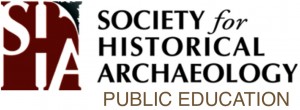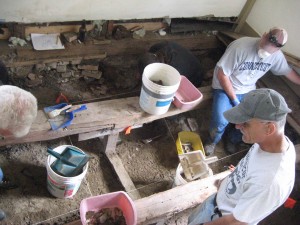Carry the One: Archaeology Education at a Math Teachers’ Conference
“Ooh! I need this! I’m teaching my kids about this soon. This one too!” The…
 Since 1997 I have been a member of the Friends of the Office of State Archaeology (FOSA) in Connecticut. I actually found out about the group on a flyer posted in an elementary school where my mom worked. I was in high school at the time. I knew I would be an archaeologist since I was a kid, and through high school and college I was a member of my local archaeological groups, including FOSA. Upon entering graduate school and having worked in cultural resource management for a few years I took to heart the growing movement of the need for more public involvement and outreach in archaeology. I dove head first into working with FOSA, and am currently the Vice President, Volunteer Coordinator, and I serve on the Newsletter and Archaeology Awareness Month Committees. I have found that a Friends group can be a great public benefit and can make substantive contributions to archaeological research.
Since 1997 I have been a member of the Friends of the Office of State Archaeology (FOSA) in Connecticut. I actually found out about the group on a flyer posted in an elementary school where my mom worked. I was in high school at the time. I knew I would be an archaeologist since I was a kid, and through high school and college I was a member of my local archaeological groups, including FOSA. Upon entering graduate school and having worked in cultural resource management for a few years I took to heart the growing movement of the need for more public involvement and outreach in archaeology. I dove head first into working with FOSA, and am currently the Vice President, Volunteer Coordinator, and I serve on the Newsletter and Archaeology Awareness Month Committees. I have found that a Friends group can be a great public benefit and can make substantive contributions to archaeological research.
The Connecticut Office of State Archaeology (OSA) has only one position, the State Archaeologist, who has no additional staff. In Connecticut the State Archaeologist is a position within the Connecticut State Museum of Natural History/Connecticut Archaeology Center at the University of Connecticut. State legislation in 1987 charged the State Archaeologist with identifying, managing, and preserving Connecticut’s archaeological resources. This is a position outside the state and federal compliance responsibilities of the State Historic Preservation Office. The State Archaeologist reviews municipal and privately funded development projects and makes recommendations that encourage the preservation of archaeological resources. The State Archaeologist is the public face of Connecticut archaeology. Talks are given throughout the state on a variety of topics to a diversity of audiences.
FOSA was established to support and assist the work of the Office of State Archaeology. Connecticut may be a small state, but it’s hard for the State Archaeologist to cover the entire state when there are projects going on and public outreach to do. The group was founded by individuals who had championed the establishment of the OSA, and who realized the OSA would still benefit from their support.
When preservation of an archaeological site is not an option in the face of development the State Archaeologist must rely on volunteer labor to complete archaeological investigations on private and town lands (with permission from the land owners). FOSA has a committee of experienced volunteers, some of them professional archaeologists by trade or training, who organize the dig, set up the grid, and maintain the site paperwork. The Volunteer Coordinator sends excavation announcements to the dig volunteers who then work on the site as available. There are several digs a year, and this season there has been at least one day of fieldwork per week.

Nick Bellantoni and FOSA Volunteers at the Strong-Howard House excavation in Windsor, 2013
Photo by FOSA
When a site excavation is complete artifacts and paperwork are returned to the OSA Lab where volunteers spend the fall through spring washing, identifying, and cataloging artifacts. This past year the lab was often at capacity, and a great deal of work was completed.
FOSA not only assists the State Archaeologist with excavation and laboratory work, but also has a very active Outreach Committee that attends fairs, festivals, farmers markets, and talks. Displays on the latest OSA work share new information about local archaeology and history with the public. Artifacts are displayed for the public to handle. Knowledgeable volunteers are on-hand to answer questions and tell people where to find more information and even how to join in the fun! FOSA has sponsored and co-sponsored public events, the largest of which is the Archaeology Fair in October (CT Archaeology Awareness Month). FOSA has an Annual Meeting that is consistently well attended by the public and has brought speakers such as James Adovasio, Douglas Owsley, and Stephen Houston to Connecticut.
Currently FOSA has over 200 members who pay annual dues to support the OSA and FOSA. FOSA has most recently donated funds to the University of Connecticut for the hire of a temporary assistant for the State Archaeologist to manage and organize the state’s archaeological site files with the goal of digitizing them and making them more accessible to researchers and professionals. FOSA also pays for the State Archaeologist’s mobile phone, as work often takes place outside the office.
FOSA provides opportunities for the public to be involved in archaeology in many different capacities even if they’re unable to dig themselves. Volunteers maintain the OSA library, and FOSA has a semiannual newsletter with member contributed articles which is edited by a Newsletter Committee. FOSA has volunteers who maintain our group’s general housekeeping like membership, nominations, and the website. Members can choose their level of activity in the group, and in the last two years we have noticed a great increase in our volunteer hours. FOSA volunteers are recognized for their hard work and have been requested on excavations for other organizations including the Joshua’s Trust, the Mashantucket Pequot Museum and Research Center, and Wesleyan University.
FOSA provides not only the support for the work of the State Archaeologist and a way to raise awareness of archaeology, but it also provides its members with a community for like-minded people. The social benefits of working together for a cause are immeasurable, and personally I have built strong friendships with many fellow volunteers. FOSA also provides a forum for professionals, students, retirees, and other members of the public to share their passion for archaeology.
It has been my experience that with a group of devoted and enthusiastic people we can raise awareness of archaeology to more people with a stronger voice. The public is looking for ways to be involved in archaeology. What I would like you all to consider is how can you organize interested members in the public to support an archaeology cause? Could a Friends group help you preserve, protect, or explore an archaeological resource that’s important to you and your community?